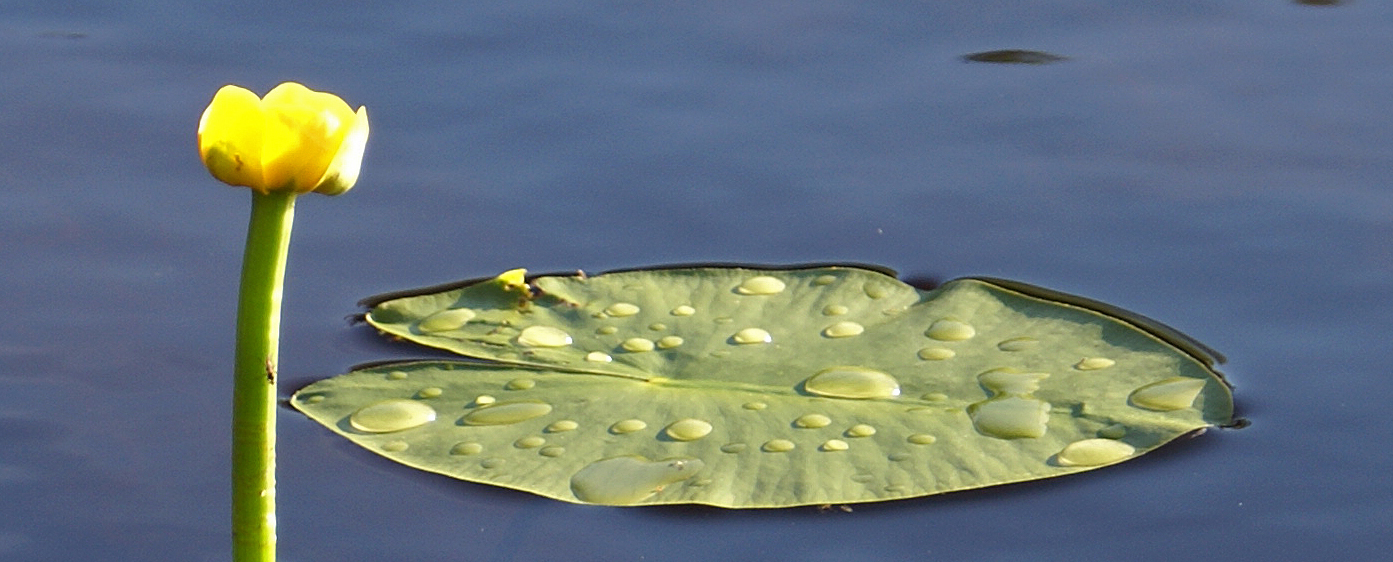Yellow Pond Lily (Nuphar spp.)
by Mel Kasting
Genus and Species: Nuphar spp. (polysepalum, luteum, variegatum, lutea)
Family: Nypmhaeaceae
Common names: Yellow Pond Lily, North American Pond Lily, Spatterdock, Water Nymph, Water Cabbage, Cow Lily, Frog Lily.
Description/Habitat: Yellow Pond Lily prefers the shallower parts of ponds, lakes, marshes, and sometimes sluggish rivers. This plant is native to the Eastern and Western United States, Africa, Temperate Asia, the West Indies, and Europe, but is naturalized all over the country. It is a rhizomatous perennial with rounded or cordate ‘lilypad’ leaves up to a foot across and a long, thick stem running down into the muck. The small, yellow, lotus-like flowers emerge on separate stems alongside the leaves.
Energetics: Cooling, Moistening
Properties: Astringent, Demulcent, Anti Inflammatory
Taste: astringent, bitter, mucilaginous
Parts Used: Rhizome
Tissue States: relaxation, excitation
Key Uses: Diarrhea and dysentery, excessive discharges from the vagina, penis, and urethra, menstrual cramps, BPH, ophthalmia, canker sores, pelvic irritation, internal and external ulcerations, especially of the vulva and penis.
History and Ethnobotany: The seeds were collected and fried in bear fat by some native american tribes. Michael Moore suggests instead to pop them like popcorn. In the pacific northwest, the seeds were an important food for the Klamath and other native american tribes. They also used the seeds mixed with oil to stop bleeding. Ethnobotanical literature shows that various native american groups used the roots for for Tuberculosis and rheumatism, heart conditions, sexually transmitted diseases and inflamed skin conditions.
Clinical Uses:
Yellow Pond Lily is a unique herb, in that it is demulcent and astringent, as well as cooling (Draw, shrink, and soothe); the “adjuster of fluids” as Matthew Wood says. The root is useful for heat and inflammation in mucosal tissues throughout the body, as well as irritated lax tissues that can’t hold onto fluids. Because of its demulcent properties, it will not overdry. Cook called it a tonic and believed it for its ability to gently soothe and tone.
Contemporary herbalists have found that Yellow Pond Lily has an affinity for the pelvic region, cooling and toning the urinary tract, as well as both male and female reproductive tract. This makes it useful for irritated prolapse and acute infections in those systems. It is less useful in the colder stages of chronic, low level infection. It is also works well for menstrual cramps, BPH, excessive vaginal and penile discharges, general irritation of the pelvic area, and as a sitz bath for irritation from sex. It is also the first herb I think of for women immediately following a D&C procedure, both physically and energetically. The key here is tissue state; think irritation and heat.
Michael Moore says that Yellow Pond Lily pain is sharper, as opposed to the dull pain of cold congestive states.
Cook also used it for diarrhea and dysentery, especially with curdy feces. Because of it’s usefulness to the mucosa, I think it would be an excellent remedy for almost all GI inflammations with heat, and for ulcerations throughout the digestive tract.
It is an excellent topical remedy for canker sores and other mouth ulcers, ophthalmia, skin inflammations, and skin ulcerations.
Note-Yellow Pond Lily is listed as an anodyne in quite a few texts, but I have not found any evidence of direct anodyne action. William Cook explains this use by saying “the relief given is not that of narcotism, but of sustaining enfeebled and congested structures.”
Energetically this plant is being used for repressed sexual and creative expression, sexual trauma, and excessive sexual cravings. I also use it to energetically support individuals who have experienced miscarriage and abortion.
Kirsten Hale, a trauma informed herbalist from the west coast, speaks eloquently of Yellow Pond Lily’s energetic uses:
“The yellow pond lily can help us with clarity about our desires, and our direction, helping energetically to facilitate the trapped desires in the lower part of the body to emerge up through the heart, without getting lost in the confusion of emotions, into the throat where they can be expressed. She helps teach us to stand clear in the midst of changing emotional landscapes, particularly when the changes are due to us outgrowing old emotional patterns and stories: in effect, allowing us to be reborn into ourselves.”
Constituents: Tannic and gallic acid (astringents), sesquiterpenoid alkaloids (including nupharine, thiobinuphaidine and desoxynupharidine), mucilage, sterols, flavonoids, glycosides
Dosage and Method of Delivery:
Fresh Root Tincture, 1:2 in 95% alcohol, 10-20 drops up to 3 times a day
Weak Decoction of the fresh or dried root, 2-4 ounces up to three times a day
A poultice of the decocted root, 3 times a day
2 ounces of decoction, as a mouthwash, 2-3 times a day
Cautions and Contraindications: This herb is cooling and not to be used with cold and stagnant tissue states.
Want more herbal goodness?
🌼Sign up for the HerbRally newsletter and receive these THIRTEEN herbal freebies!
VIDEO | Most Vital Herb in David Hoffmann’s First-Aid Kit
WEBINAR | Herbal First Aid with Heather Irvine
EBOOK | 86 Page Plant Healer Book
30 DAYS FREE | HerbRally Schoolhouse
EBOOK | Calendula for Radiant Skin by Rosalee de la Forêt
VIDEO | 5 Herbal Events Around the World presented by Bevin Clare
BOOK DISCOUNT | The Essential Guide to Western Botanical Medicine
PRIVATE COMMUNITY | HerbRally Facebook Group
BOOK EXCERPT | 36 Pages from Plant Healer's "Nourishing Foods" Book
DISCOUNT | 15% off all Mountain Rose Herbs products
DISCOUNT | Mushroom Revival
AUDIO | Hour-long Adaptogens Class with Heather Irvine
DISCOUNT | 10% off all HerbRally products
👉 CLAIM YOUR FREEBIES!
Mel Kasting is a graduate of the Columbines School of Botanical Studies, a budding community educator, and an advanced student with the Eclectic School of Herbal Medicine. She has a small sliding scale clinical practice based in St. Louis, Missouri and formulates all of her own medicines. Mel's passion, in the clinic and community, is education. She wants to open an herb school someday.
REFERENCES:
http://www.fcps.edu/islandcreekes/ecology/yellow_pond_lily.htm
http://www.crazyherbalist.com/yellow-pond-lily-cool-moist-beautiful/
http://www.henriettes-herb.com/eclectic/kings/nymphaea.html
https://plants.usda.gov/plantguide/pdf/pg_nulu.pdf
The Physiomedical Dispensatory by William Cook, M.D., 1869
Wood, Matthew. 2009. Earthwise Herbal, A Complete Guide to New World Medicinal Plants. North Atlantic Books, Berkeley, CA.






